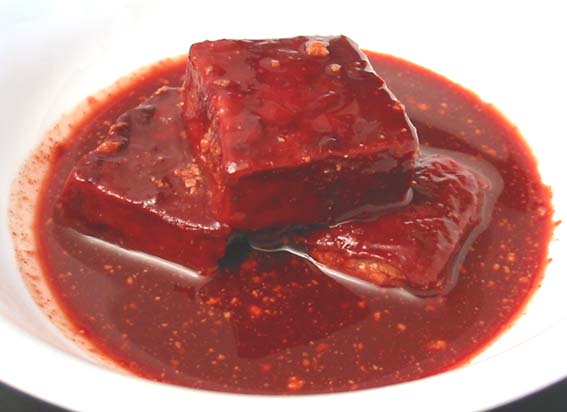 Fermented tofu also called fermented bean curd, sufu, tofu cheese, or preserved tofu is a form of processed, preserved tofu used in East Asian cuisine as a condiment made from soybeans. The ingredients typically are soybeans, salt, rice wine and sesame oil or vinegar, and are sold in jars containing blocks 2- to 4-cm square by 1 to 2 cm thick soaked in brine with select flavorings
Fermented tofu also called fermented bean curd, sufu, tofu cheese, or preserved tofu is a form of processed, preserved tofu used in East Asian cuisine as a condiment made from soybeans. The ingredients typically are soybeans, salt, rice wine and sesame oil or vinegar, and are sold in jars containing blocks 2- to 4-cm square by 1 to 2 cm thick soaked in brine with select flavorings

Serving
Fermented tofu is commonly used as a condiment and is consumed at breakfast to flavor rice, porridge, gruel or congee. Usually either several bricks are placed in a small bowl covered in the flavored brine or one to one half bricks are placed into a bowl. Then, chunks are broken off the brick and consumed with a mouthful of porridge or gruel. The brine may also be used for flavoring. Fermented bean curd can also be added in small amounts, together with its brine, to flavor stir-fried or braised vegetable dishes (particularly leafy green vegetables such as water spinach).
Characteristics
Fermented bean curd has a special mouthfeel similar to certain dairy products due to the breakdown of its proteins which takes place during the air drying and fermentation. Lacking strong flavor, fermented bean curd takes on the aroma and taste of its soaking liquid. The flavor is salty with mild sweetness. The texture and taste of fermented bean curd resembles a firm, smooth paste not unlike creamy blue cheese. (Indeed, this kind of tofu is sometimes called "Chinese cheese" in English). Refrigerated, it can be kept for several years, during which time its flavor is believed to improve.
Varieties
 White (bái) preserved bean curd (fǔrǔ) is the most common type and can be described without the white adjective. The flavor, color and aroma can be altered using various combinations of spices and seasoning in the brine with alterations in the commonly used combination of 10% rice wine and 12% salt. Those with no alcohol produces "small cheese cubes" (hih-fang) while those with double the alcohol content produces "drunken cheese" (tsui-fang).This variety is also available with chili and/or sesame oil. Seasonings can include anise, cinnamon, lemon juice, lemon zest, dried shrimp, and ham. In addition, one can also obtain the curd dried, and without brine, which are then sold in paper cartons.
White (bái) preserved bean curd (fǔrǔ) is the most common type and can be described without the white adjective. The flavor, color and aroma can be altered using various combinations of spices and seasoning in the brine with alterations in the commonly used combination of 10% rice wine and 12% salt. Those with no alcohol produces "small cheese cubes" (hih-fang) while those with double the alcohol content produces "drunken cheese" (tsui-fang).This variety is also available with chili and/or sesame oil. Seasonings can include anise, cinnamon, lemon juice, lemon zest, dried shrimp, and ham. In addition, one can also obtain the curd dried, and without brine, which are then sold in paper cartons.
Red fermented bean curd (Chinese: 紅腐乳/南乳; pinyin: hóngfǔrǔ/nánrǔ), incorporates red yeast rice (cultivated with Monascus purpureus) with the brining liquor for a deep-red color and distinctively thickened flavor and aroma. This variety may also contain chili. A popular derivative of this variety has an appearance of ketchup and is seasoned with rose essence, caramel and natural sugar.
Stinky fermented bean curd is fermented for over six months and is also popular due to its strong creamy flavor. However due to its strong acrid smell, this variety is an acquired taste.Note that stinky sufu differs from stinky tofu in appearance, consistency and salt content. Stinky sufu are made in the same cube-like shapes and has a similar smooth soft creamy texture as regular white sufu. In Taiwan, a green version is popular and made with sake lees, crushed leaves and a green mucor mold. It is then fermented for 12 hours and sold on the streets.
Chiang fermented bean curd (Chiang-doufu) is made with cubes of tofu soaked in either Chinese-style miso (Chiang) or soy sauce for several days. Usually reddish-brown in color and salty, it may be dried and fermented further and also may also be mixed with sake lees. In Japan, miso is used.
History
According to Bencao Gangmu (Pen Ts'ao or Chinese Materia medica), by Li Shizhen (1596), the creation of soybean curd is attributed to Liu An (179 – 122 BC), king of Wainan. Manufacture spread began during the Han Dynasty in China after it was created.The date when the preservation of this curd began is unknown, but most likely was derived from those wishing to preserve the curd that had appeared to have gone bad.
The Food Encyclopedia, written by Wang Su-Hsiung (1861) of Qing Dynasty, made reference to preserved bean curd as superior to difficult-to-digest, hardened tofu especially for the elderly, children and ill persons.
No comments:
Post a Comment